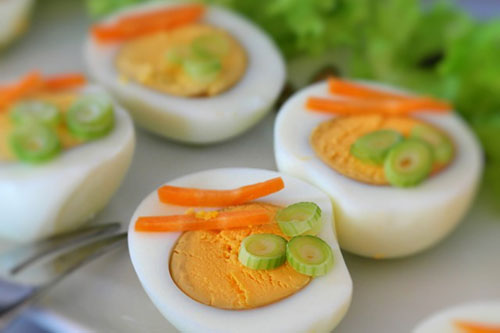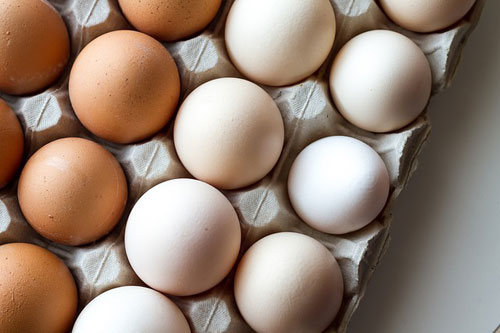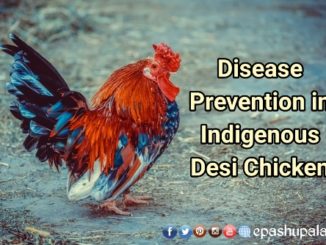Introduction
Eggs are nutrient dense super foods that comprise essential vitamins and all nine essential amino acids making it a source of complete protein and one of the food that naturally contains vitamin D. On the breakfast table, they may be enjoyed depending on the region as scrambled egg, hard-boiled egg, as a fried egg with ‘Sunnyside up’. They provide health benefits like reducing macular degeneration, boosts immune system, improving brain activity. Despite having high nutrient value, some consumers limit their egg intake due to adverse publicity about saturated fats and cholesterol. People demand eggs which are safe, free from drugs/ other harmful substances and also high in special health promoting substances like n-3 omega fatty acids, anti-oxidants, etc., for that designer eggs are made to reap the growing demand of health conscious consumers.

“Egg”cellant composition
The main components of the hen’s egg are: water (74%), protein (13%), fat (11%), carbohydrates (1%) and other nutrients with minor percentage including minerals, vitamins and carotenoids. Egg’s macrostructure is approximately 9-12% of shell, 60% of albumen and 30-33% of yolk. Yolk lipid content is around 33% including 63.3% of triacylglycerols, 29.7% of phospholipids and 5.2% of total cholesterol.
Taking the average egg of size 50 g its nutrient composition is depicted in the following table.
| Serving Size | 1 egg (50g) |
| Amount per Serving | |
| Calories | 70 |
| % Daily Value | |
Total fat 5g
|
6%
|
| Cholesterol 185mg | 62% |
| Sodium 70mg | 3% |
Total Carbohydrate 0g
|
0%
|
| Protein 6g | 12% |
| Vitamin D 1mcg | 6% |
| Calcium 28mg | 2% |
| Iron 1mg | 6% |
| Potassium 69mg | 2% |
| Riboflavin 0.2mg | 15% |
| Vitamin B12 0.4mcg | 15% |
| Biotin 10mcg | 35% |
| Pantothenic Acid 1mg | 20% |
| Iodine 27mcg | 20% |
| Zinc 1mg | 10% |
| Selenium 15mcg | 25% |
| Molybdenum 8mcg | 20% |
| Choline 147mg | 25% |
Designer eggs
Designer eggs are those eggs their content has been modified from the standard egg .The concept was first developed by Dr. Sung. J. Small percentage of egg sold are designer eggs (3%). The nutrient composition of the egg is greatly influenced by the diet of the hen. It is not possible to make major changes to the total amount of fat present in the yolk but it is easy to modify its fatty acid profile by dietary manipulation of the hen. The least changeable composition is protein.

Varieties of designer eggs
- High vitamin content
- High mineral content
- Alteration in the pigment content
- Low cholesterol
- Fat and fatty acid profile
- Pharmaceutical operations
- Biological compounds
High vitamin content
Designer eggs can be produced with higher concentrations of several vitamins particularly vitamin A and E. Although, the vitamin content of eggs varies with the diet of hen but the hen may also differ in transferring the different vitamins with different efficacy. It is highest for vitamin A (60-80%), vitamin B12, riboflavin, biotin and pantothenic acid (40-50%), vitamin D3 and vitamin E (15-25%).
High mineral content
Most of minerals particularly calcium and phosphorus are present in egg shell. So altering the calcium and phosphorus level of edible portion of egg (albumin and yolk) is very difficult. However, scientists have achieved the success in increasing the micro mineral contents of these portion especially selenium, iodine, zinc, copper and chromium by dietary supplementation. Iodine deficiency exists in many developing countries including India. Selenium level in eggs can be increased by incorporating the selenium yeast in diet of hens.
Alteration in pigment content
The yolk colour is the indicator of pigment content of egg and varied with dietary supplementation such as plants viz., marigold, chilli or corn; blue green algae viz., spirulina. Recently in a study, it was found that high intake of carotenoids reduced the macular degeneration, a major cause of blindness in the elderly.
Low cholesterol
Supplementation of chromium to laying hen diets at concentrations of less than 1 ppm have been shown to lower egg cholesterol and also improve the interior egg. The low cholesterol eggs can be produced by feeding an all-vegetarian diet rich in protein and fibre fortified with vitamin E.
Fat and fatty acid profile
High amount of Polyunsaturated Fatty Acids (PUFA) in the diet of human beings promote the infant health and reduces the chances of atherosclerosis, heart attack and stroke. The inclusion of safflower oil, marine algae, fish oil, fish meal and vegetable oil in feeds of the poultry increases the omega-3 fatty acid content in the egg yolk which is vital nutrient for adult and children.
Pharmaceutical alterations
With the advancement of biotechnology, we can produce genetically modified chickens which then produce the eggs containing the desired compound e.g., insulin for the treatment of diabetic patients.
Biological compounds
Like many other animals, chicken can also produce antibodies that can neutralize the antigens of bacteria, viruses etc. Specific antigens can be selected and injected into the hen for developing antibodies against them. Chicken can synthesize and deposit interferons, monoclonal antibodies, recombinant human antibodies against autoimmune diseases, and cancer etc.
Conclusion
Eggs are natural life supporting nutritional pills. But designer eggs are fortified with lutein, DHA, vitamins, minerals (especially selenium), pigment content, lowered cholesterol level, for delivering pharmaceutical products and to provide biological compounds. Designer eggs makes them perfect food for infants, adults, patients with the cardiac ailments, also recommended for the Alzheimer’s persons and for preventing the macular degeneration of the aged persons. Designer eggs offer an alternative choice of food product to today’s nutrition-health conscious consumers around the world. The future of the poultry industry is not just producing the more number of eggs but also a nutritional product. Eggs are the chief source of protein for the poor all over the nation. Since our ICMR recommendation is 180 eggs/annum/per head, the availability is in very meagre level. All the governments should take actions to promote consumption of eggs among the people to avoid malnutrition among the growing generation. Also organizations like NECC should take measures to create health awareness on initiatives like designer eggs among the general public.
| “ Designer eggs – an unbeatable companion, manipulation for mankind” |






1 Trackback / Pingback